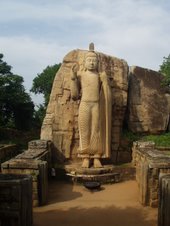The island of Sri Lanka has been of interest to foreigners for a long time. The ancestors of the South Indian Tamils – the Dravidians – were present in Sri Lanka from pre-historic times. So there has been a great deal of communication between India and Sri Lanka for a long time. The history of Sri Lanka is run through with violence between the Sinhalese people (which are reputably of Northern Indian stock and may have originally come from Persia) and the Sri Lankan Tamils. An influx of Tamil settlers brought on several Sinhala-Tamil wars during the early period of Sri Lankan history. Which people are more indigenous, of course, is a questionable matter – certainly the Sinhalese settled there first, but the Sri Lankan Tamils have lived there in some form for many thousands of years developing their own unique culture that distinguishes them from their Indian cousins.
(Image of Sri Lanka care of "Lonely Planet": Most Tamils live in the north and east of Sri Lanka, while there is a concentration of Moors in South-east Sri Lanka (around Ampara and Batticalloa). The Singhalese predominate however, and dominate much of the island population).

Even Roman traders plied Sri Lankan waters as they went about taking advantage of Sri Lanka’s twin monsoons. The Egyptians were trading spice as early as 1400 bce! Arabs, Malays and Indonesians were also popular visitors. The upshot of this early trade was that sea charts were easily available for many years making subsequent invasion by foreign powers a rather simple affair.
(Sri Lanka's Flag: The lion is a Singhalese national symbol, the leaves at the four corners are Bo leaves and represent Buddhism, the maroon colour is a Singhalese colour, while the green and biege represents the Tamils and Moors - Muslims - respectively).

Later, the Portuguese colonized the coast of Sri Lanka starting in 1505, essentially dominating the island economically. Subsequent to this, the Dutch invaded and wrestled control of the island from the Portuguese during the 1700’s. Finally, the English declared Sri Lanka a crown colony in 1802 and developed much of the infrastructure currently in use today. It was also the English that managed to control the inland, defeating the Kandyan Kingdom and defeating the Sinhala army that had for so long maintained control. The lengthy colonization of the Sri Lankan coast has resulted in a more cosmopolitan feel and outlook in coastal areas, and a more rural and simple way of life inland. Nonetheless, most Sinhalese look to the high country for cultural inspiration since it remains somewhat unchanged since English dominion.
Colombo city - trading centre of Sri Lanka:

In spite of this colonialism, the Sri Lankan people still retain a unique culture and society, in many ways no different from the practices of their ancestors. In spite of the violent history the settlers brought, the Sri Lankan people seem to harbour no ill sentiment towards foreigners. The Sinhalese generally regard white people (sudhas) very warmly as if they represent a high point in Sri Lankan history. Nonetheless, they are often amused by the peculiar antics of tourists sometimes secretly calling them pissu-suddha “crazy white people”. This is always said in a very light-hearted way of course, but the term is – when one thinks about it – quite astute. This is often because suddhas become thakkali-suddha “tomato suddha” on account that they go directly from the airport to beaches – usually Bentota on the west coast – and become ragingly sunburnt (an impossibility for the locals). There are other reasons why suddhas might be classified as odd: they tool around in floral pattern shorts with ridiculous hats and take pictures of stray dogs (guilty! – I’ll show my collection of stray dogs later).
Then there are kalu-suddha “black-whities”. This term is a derogatory term usually reserved for Sri Lankans who have moved overseas and forgotten their roots (i.e. their language). However, it can occasionally be applied to foreigners who have appropriated certain Sri Lankan practices (e.g. eating food with the right hand, knowing Singhala, etc, etc). I’ve seen quite a few tourists floating around here and there – almost always at hotels and tourist spots. I’ve heard that there is a real dearth of tourists at the moment due firstly to the effects of the Boxing Day tsunami but secondly because of the civil war that has recently been re-ignited. For this reason I have never experienced how busy Sri Lanka can really be. But it is telling, I think, that being in the company of suddhas is something of an oddity in my case and when I am amongst them in force (for example when I visited the shop “Barefoot” – a staple tourist hangout) I feel rather out of place. Having said all this about the local attitude to foreigners, many locals however often regard their own people as pissu “crazy”, so in this vein the following phrase is probably appropriate: okomma miniho pisso “all people are crazy”.

No comments:
Post a Comment